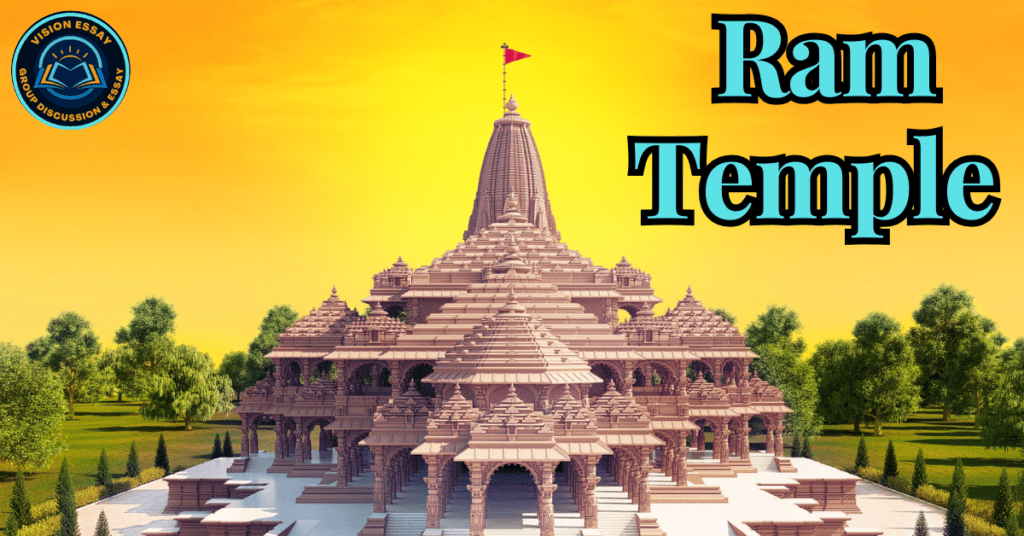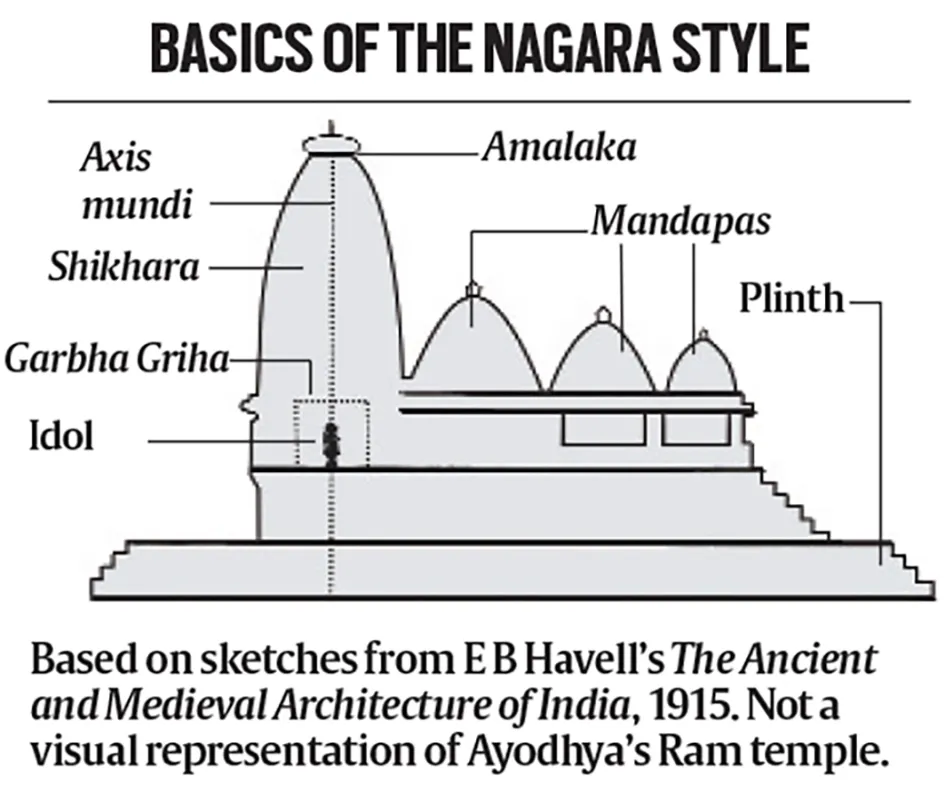
Introduction
With the opening of the Ayodhya Ram temple on January 22, 2024, a 200-year tale that had a significant influence on India’s sociopolitical climate came to an end. The Nagara Style of temple architecture is used in the design of the Ayodhya Ram temple.
What is the Historical Background of Ayodhya Ram Temple?
- Origin
- The campaign acquired impetus in the 19th century after the Marathas filed an appeal for control over Ayodhya, Kashi, and Mathura in 1751. Court documents from 1822 describe a mosque on the site of Lord Ram’s birth.
- Clash Near Babri Masjid
- When Hindus and Muslims engaged in a bloody skirmish close to the Babri Masjid in 1855, tensions increased and the Hindus went on to conquer Janmasthan.
- Placement of the idol of Ram Lalla
- The installation of the Ram Lalla deity in the mosque in 1949 led to calls for the construction of a large temple.
- Legal Battles
- A movement for the ‘liberation’ of Ram Janmabhoomi, Krishna Janmabhoomi, and Vishwanath temple was started in the 1980s by the Vishwa Hindu Parishad (VHP).
- After several legal disputes, the Babri Masjid’s locks were unlocked in 1986 to permit Hindus to pray there.
- Significant events occurred in the years that followed, including as the 1989 foundation-laying ceremony and the LK Advani-led Rath Yatra in 1990 that sparked extensive rioting.
- Demolition of Babri Masjid
- A mob destroyed the Babri Masjid on December 6, 1992, which resulted in legal actions and political fallout.
- The government was granted permission to obtain the land claimed by Ram Janmabhoomi and Babri Masjid in 1993 when the Acquisition of Certain Areas at Ayodhya Act was enacted by Parliament.
- In 2009, the Liberhan Commission emphasized how planned the events of 1992 were.
- Allahabad High Court Verdict
- In its Ayodhya title suit ruling in 2010, a special bench of the Allahabad High Court split the land in a 2:1 ratio, giving two-thirds of the 2.77 acres—including the Garbha Griha—to the petitioners seeking to build a Ram temple, Shri Ram Lala Virajman and Nirmohi Akhara.
- The Sunni Central Waqf Board was awarded one-third of the land.
- Supreme Court Verdict
- After many years of litigation, the Supreme Court granted the Hindu petitioners full ownership of the contested site in 2019 so they could build a Ram temple there while allocating land for a mosque elsewhere.
- Finalization
- The Indian Prime Minister conducted the Shilanyas of the Ram temple on August 5, 2020, marking the establishment of the Shri Ram Janmabhoomi Teerth Kshetra Trust, marking the completion of this historic journey.
- The Nagara-style Ram temple at Ayodhya was scheduled to open on January 22, 2024, bringing an end to a 200-year-old tale that had a significant influence on India’s sociopolitical climate.
What is the Uniqueness of Ayodhya Ram Temple?
- Traditional Architecture and Construction
- Constructed in the classic Nagara style, this three-story temple rises majestically from the pink sandstone of Mirzapur and the hills of Bansi-Paharpur, Rajasthan.
- Temple is a magnificent architectural work of art spanning 71 acres.
- Temple Dimensions
- The main temple area is 2.67 acres in size, measuring 250 feet in width and 161 feet in height. It has 390 pillars, 46 doors, and 5 mandaps.
- Unique Features Inside
- Ram Lalla idols are housed in the main Garbh Griha along with other mandaps, such as the Rang and Nritya mandaps.
- Innovative Anointment Tradition
- Every Ram Navami at midday, the sun’s beams are directed onto Ram Lalla’s idol by a system of mirrors and lenses. This special salve doesn’t need power since brass is used in place of iron or steel.
- Sculptor’s Contribution
- Mysuru sculptor Arun Yogiraj created the 51-inch-tall idol of five-year-old Ram Lalla, which was dedicated in a unique ceremony.
- Durability and Symbolism
- The temple was built without the use of iron and is meant to last for at least a millennium.
What is the Nagara Style of Ayodhya Ram Temple Architecture?
- About
- The late Gupta era in northern India around the fifth century CE saw the emergence of the Nagara style of temple architecture.
- It is compared to the Dravida style, which also originated in southern India during the same period.
- Distinguished by a Towering Shikhara
- The Garbha Griha (sanctum sanctorum), which houses the idol of the god, is the most sacred area of Nagara temples, which are constructed on high plinths.
- The most defining feature of Nagara-style temples is the shikhara, which means “mountain peak” and towers over the Garbha Griha.
- A mandapas (halls) on the same axis as the Garbha Griha and a strolling corridor around it are further features of a typical Nagara-style temple. Rich murals and reliefs frequently cover its walls.

How Did the Ramayana and Shri Ram Be Famous Outside of India?
- Trade Routes and Cultural Exchange
- Through land and maritime trading channels, the Ramayana was disseminated. Indian traders brought cultural artifacts, such as religious tales, along with them as they traveled for business.
- Land routes helped spread the Ramayana to places like China, Tibet, Burma, Thailand, and Laos. Examples of these routes are the northern one, which passes via Punjab and Kashmir, and the eastern one, which passes through Bengal.
- The epic was disseminated by maritime channels, especially the southern route from Gujarat and South India, reaching locations like as Java, Sumatra, and Malaya.
- Cultural Transmission by Indian Communities
- Indian traders were instrumental in introducing Indian culture, customs, and philosophy to the people of Southeast Asia, as were Brahmin priests, Buddhist monks, academics, and explorers.
- The Ramayana eventually shaped art, architecture, and religious rituals in several Southeast Asian nations, becoming an essential component of their cultures.
- Integration into Local Culture
- In many respects, the Ramayana blended in with the indigenous civilizations. For instance, it is thought that the Ayodhya of the Ramayana served as the model for the Ayutthaya empire in Thailand.
- The Angkor Wat temple complex in Cambodia has paintings that portray episodes from the Ramayana. The temple complex was initially devoted to Vishnu.
- Evolution of the Epic
- In several places, the Ramayana was given unique regional tastes and adaptations. For example, Thailand’s national epic is the Ramakien, which was inspired by the Tamil epic Kamban Ramayana.
- Unique aspects were introduced into many versions in other nations. For example, characters with Tamil names were depicted in the Thai Ramakien.
- Spread Through Indentured Labor Migration
- The Girmitiya Migration of the 19th century led to the Ramayana’s dissemination to areas such as Fiji, Mauritius, Trinidad & Tobago, Guyana, and Suriname.
- The Ramcharitmanas were one of the cultural and religious customs that indentured servants brought with them to their new homes.
- Continued Cultural Practices
- Many Southeast Asian nations still consider the Ramayana to be an important component of their national cultures. It is preserved through a variety of artistic mediums, such as puppet shows, dance dramas, plays, and religious rituals.
Conclusion
Inaugurating on January 22, 2024, the Ayodhya Ram Temple marks the culmination of a 200-year saga that shaped India’s sociopolitical fabric. The Nagara-style architecture, rooted in ancient traditions, adorns the sprawling 71-acre site. With its unique features, innovative anointment tradition, and durability, the temple stands as a testament to faith and craftsmanship. Beyond borders, the epic of Shri Ram and Ramayana’s enduring influence on Southeast Asia attests to the cultural interconnectedness fostered by trade, migration, and integration.
Frequently Asked Question(FAQs)
What is a story of Ayodhya Ram Temple?
Resolving a long-standing Hindu nationalist vow is the construction of the Ram temple at Ayodhya. On the site of a temple where the Hindu deity was born, many Hindus think that Muslim conquerors constructed the Babri mosque. The BJP’s rise to political prominence in the 1990s was aided by the temple-building campaign.
Which trust is making Ayodhya Ram Temple?
When the temple was first being built, the Shri Ram Janmabhoomi Teerth Kshetra Trust, which was given construction oversight, estimated that the project would cost around ₹1,800 crore ($217 million).
Who donated money to Ayodhya Ram Temple?
“Mukesh Ambani gave the Ram Janmabhoomi Teerth Kshetra Trust ₹2.51 crore, together with his family. The Ram Mandir in Ayodhya is a holy project with great cultural significance, they declared in a statement.
Why Ayodhya Ram Temple is so important?
Building the Ram Mandir represents the people’s tenacity and commitment while also realizing a long-held aspiration for many. As a pilgrimage destination, Ayodhya never fails to draw followers looking for enlightenment and a closer relationship with God.
Sources:
- https://timesofindia.indiatimes.com/speaking-tree/daily-ecstasy/rams-triumph-exploring-the-power-of-responsibility/articleshow/107039187.cms
- https://economictimes.indiatimes.com/news/how-to/mokshdayani-sapt-puri-why-ayodhya-holds-a-prominent-place-among-the-seven-most-important-pilgrimage-sites-for-hindus/articleshow/107048810.cms?from=mdr
- https://www.nytimes.com/2024/01/22/world/asia/modi-india-ram-temple.html
- https://en.wikipedia.org/wiki/Ram_Mandir
- https://www.bbc.com/news/world-asia-india-68003095
- https://indianexpress.com/specials/ayodhya-ram-mandir/
- https://www.hindustantimes.com/ayodhya-ram-mandir-opening-ceremony
